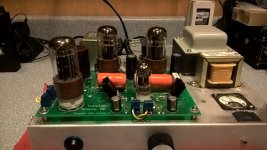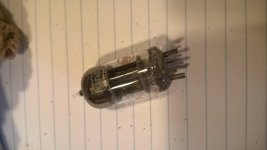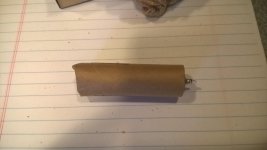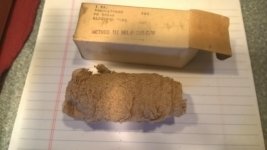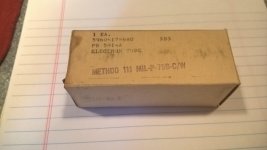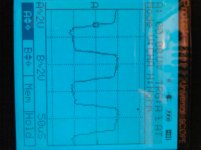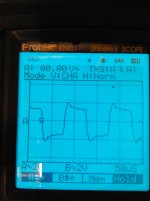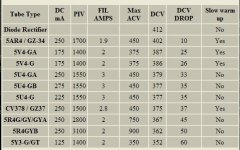I've fiddled with quite this a bit over the last few weeks, mostly with 6V6, since that is what I originally built it for.
I knew from playing around with another board and external supplies that I needed to get my B+ down around 250 volts or so for reasonable SMPE IMD numbers, which, unfortunately, is my only means of analysis at present. When all you have is a hammer, everything looks like a nail, so I'm stuck with this for awhile longer.
The only way to get there with my existing PT is a choke input supply. I pulled the first cap, kept the 5H choke, and left the existing cap which was a 400 volt 120 or 150 uF device. On 96dB speakers, I could hear a bit of hum within a few inches of the speakers, so I pulled the last cap and substituted a 1200 uF, 250 volt cap, in it's place. It is totally silent - you can't even tell the amp is on.
This got the B+ acceptably low, but presented another significant problem - there is a voltage floor, below which the front end just won't work without alteration. That floor is right around 245 volts, and, at these very low voltages, 12AT7's have to be hand selected. Most won't work correctly and show horrific distortion numbers - it takes a large pool to draw from to find an example that will show low distortion. At 255-260 volts, a few more will work correctly, and as voltage increases, more and more will work. Obviously, this is tedious and wildly impractical if one does not have a large quantity of tubes on hand.
There is a further problem - at these low B+ voltages, the 6AX5 voltage drop compounds the problem: I could not find a 12AT7 in my stock that would perform acceptably well in this configuration. A 6X5 has a lot less voltage drop, but, in theory, can't supply the needed current even with the current boost allowed by an LC supply.
With a 6X5 rectifier, and some gnarly old GE 6V6 that I hand selected, here are some numbers. This is in Ultra Linear with cathode feedback, which doesn't seem to make much difference one way or the other at these very low power levels:
Plate voltage: 249
Screen voltage: 252
cathode voltage: 10
cathode current 56 ma
Power dissipation: 13 watta
Rk 180 ohms
IMD at 1 watt was 30%; at 0.5 watt 10%; at 0.10 watt 3%; and 50 milliwatts was 2.2 %.
SE Amp cad predicted 3.3% 2nd harmonic and 1.1% third harmonic at this point, as a triode amplifier.
The 6X5 seems to have a bad reputation and running one at twice the permitted current would look to be an invitation to disaster, but, it didn't give me any trouble. I used a National 6X5 of all things, that they had thoughtfully mis marked as a 6AX5, that had a big bulb and heavy ceramic base, similar to a 5852, and it shrugged off this insult and worked fine for several weeks, with long hours of daily use. Just looking at it, you can't even tell it's been used.
Win W5JAG
I knew from playing around with another board and external supplies that I needed to get my B+ down around 250 volts or so for reasonable SMPE IMD numbers, which, unfortunately, is my only means of analysis at present. When all you have is a hammer, everything looks like a nail, so I'm stuck with this for awhile longer.
The only way to get there with my existing PT is a choke input supply. I pulled the first cap, kept the 5H choke, and left the existing cap which was a 400 volt 120 or 150 uF device. On 96dB speakers, I could hear a bit of hum within a few inches of the speakers, so I pulled the last cap and substituted a 1200 uF, 250 volt cap, in it's place. It is totally silent - you can't even tell the amp is on.
This got the B+ acceptably low, but presented another significant problem - there is a voltage floor, below which the front end just won't work without alteration. That floor is right around 245 volts, and, at these very low voltages, 12AT7's have to be hand selected. Most won't work correctly and show horrific distortion numbers - it takes a large pool to draw from to find an example that will show low distortion. At 255-260 volts, a few more will work correctly, and as voltage increases, more and more will work. Obviously, this is tedious and wildly impractical if one does not have a large quantity of tubes on hand.
There is a further problem - at these low B+ voltages, the 6AX5 voltage drop compounds the problem: I could not find a 12AT7 in my stock that would perform acceptably well in this configuration. A 6X5 has a lot less voltage drop, but, in theory, can't supply the needed current even with the current boost allowed by an LC supply.
With a 6X5 rectifier, and some gnarly old GE 6V6 that I hand selected, here are some numbers. This is in Ultra Linear with cathode feedback, which doesn't seem to make much difference one way or the other at these very low power levels:
Plate voltage: 249
Screen voltage: 252
cathode voltage: 10
cathode current 56 ma
Power dissipation: 13 watta
Rk 180 ohms
IMD at 1 watt was 30%; at 0.5 watt 10%; at 0.10 watt 3%; and 50 milliwatts was 2.2 %.
SE Amp cad predicted 3.3% 2nd harmonic and 1.1% third harmonic at this point, as a triode amplifier.
The 6X5 seems to have a bad reputation and running one at twice the permitted current would look to be an invitation to disaster, but, it didn't give me any trouble. I used a National 6X5 of all things, that they had thoughtfully mis marked as a 6AX5, that had a big bulb and heavy ceramic base, similar to a 5852, and it shrugged off this insult and worked fine for several weeks, with long hours of daily use. Just looking at it, you can't even tell it's been used.
Win W5JAG
After blowing some diodes to smithereens, smoking a meter, and melting a test lead making a voltage quadrupler from my free 5 volt secondary for a fixed bias supply, I dismissed that idea temporarily ( maybe permanently ) and decided to use it for it's intended purpose: a rectifier supply.
For those interested in converting the SSE socket to 6X5/6AX5 it's easy:
jumper pins 3 and 4;
jumper pins 5 and 6;
6.3 volt filament power goes to pins 2 and 7.
Conversion back to traditional 5 volt rectifers, gave me a bit more flexibility in establishing a range of B+ voltages. Along the way, I also found, maybe, a solution to the 12AT7 problem at these very low B+ voltages. That solution may be the 12AU7. For whatever reason, 12AU7, with no need to hand select, seem to work reliably at voltages down to 225 volts, with no significant distortion penalty.
As an example, here are some numbers from a combination of a 5W4 rectifier, some RCA 6V6GT, and an awesome looking triple mica, two support rod, black plate, RCA 12AU7, still in UL with CFB:
Plate voltage: 225
Screen voltage: 228
cathode voltage: 9
cathode current 50 ma
Power dissipation: 10.75 watts
Rk 180 ohms
IMD at 1 watt was 38%; at 0.5 watt 13%; at 0.10 watt 3%; and 50 milliwatts was 2.5 %.
The 12AU7 presents its own unique problems. The gain is considerably less. This could be a problem in some applications. It is not in mine. There may be other distortion issues with it - I plan on expanding to a pc type of analysis but that is presently thwarted by a dead pc.
However, it sounds quite good. The amp is eerily quiet - signals just jump out from a black background of silence. More improvement may be available, but it clearly sounds better than it's original build. I'm weighing replacing the OPT's. I think with a higher load, I could have done a lot better at the higher voltages. I'm leaning to the Hammond 125CSE since I've been well satisfied with the 125ESE, but that is still up in the air, and not going to happen soon, if at all.
Along the way, I also changed the Auricap coupling caps to Orange Drops, for no particular reason other than to try them. The distortion readngs in this and the previous post were made with the orange drops.
For those interested in converting the SSE socket to 6X5/6AX5 it's easy:
jumper pins 3 and 4;
jumper pins 5 and 6;
6.3 volt filament power goes to pins 2 and 7.
Conversion back to traditional 5 volt rectifers, gave me a bit more flexibility in establishing a range of B+ voltages. Along the way, I also found, maybe, a solution to the 12AT7 problem at these very low B+ voltages. That solution may be the 12AU7. For whatever reason, 12AU7, with no need to hand select, seem to work reliably at voltages down to 225 volts, with no significant distortion penalty.
As an example, here are some numbers from a combination of a 5W4 rectifier, some RCA 6V6GT, and an awesome looking triple mica, two support rod, black plate, RCA 12AU7, still in UL with CFB:
Plate voltage: 225
Screen voltage: 228
cathode voltage: 9
cathode current 50 ma
Power dissipation: 10.75 watts
Rk 180 ohms
IMD at 1 watt was 38%; at 0.5 watt 13%; at 0.10 watt 3%; and 50 milliwatts was 2.5 %.
The 12AU7 presents its own unique problems. The gain is considerably less. This could be a problem in some applications. It is not in mine. There may be other distortion issues with it - I plan on expanding to a pc type of analysis but that is presently thwarted by a dead pc.
However, it sounds quite good. The amp is eerily quiet - signals just jump out from a black background of silence. More improvement may be available, but it clearly sounds better than it's original build. I'm weighing replacing the OPT's. I think with a higher load, I could have done a lot better at the higher voltages. I'm leaning to the Hammond 125CSE since I've been well satisfied with the 125ESE, but that is still up in the air, and not going to happen soon, if at all.
Along the way, I also changed the Auricap coupling caps to Orange Drops, for no particular reason other than to try them. The distortion readngs in this and the previous post were made with the orange drops.
Here are a few pics of the latest iteration, dressed out in righteous cold war tube glory.
Interestingly, the 5992 seem to have higher distortion than other 6V6 types. I remember when I was playing with 6889, they had a very apparent audible distortion drop after a half hour or so. I haven't really had the time to let the 5992's just sit on the meter for an hour to see if they have the same characteristic.
Also interestingly, while the 6106 and a 5Y3WGTB/6087 rectifier put out voltage within a few volts of each other, the 6106 actually being a few volts less, 12AT7 tubes that would not show an acceptable distortion characteristic with the 6087, would show acceptable distortion characteristics with the 6106. So, maybe there is an audible difference among rectifier tubes apart from their change in operating points, and people that say they can hear differences with different rectifier tubes may in fact be able to do so. I didn't try, and doubt that I could.
Also are some pics of the extensive packaging that the RCA 12AU7 came in. I have quite a lot of these tubes. You may not be able to see from the pic, but the pins were snaggle toothed, and I am sure it had never been out of the packaging - removing one destroys it.
Win W5AJG
Interestingly, the 5992 seem to have higher distortion than other 6V6 types. I remember when I was playing with 6889, they had a very apparent audible distortion drop after a half hour or so. I haven't really had the time to let the 5992's just sit on the meter for an hour to see if they have the same characteristic.
Also interestingly, while the 6106 and a 5Y3WGTB/6087 rectifier put out voltage within a few volts of each other, the 6106 actually being a few volts less, 12AT7 tubes that would not show an acceptable distortion characteristic with the 6087, would show acceptable distortion characteristics with the 6106. So, maybe there is an audible difference among rectifier tubes apart from their change in operating points, and people that say they can hear differences with different rectifier tubes may in fact be able to do so. I didn't try, and doubt that I could.
Also are some pics of the extensive packaging that the RCA 12AU7 came in. I have quite a lot of these tubes. You may not be able to see from the pic, but the pins were snaggle toothed, and I am sure it had never been out of the packaging - removing one destroys it.
Win W5AJG
Attachments
This got the B+ acceptably low, but presented another significant problem - there is a voltage floor, below which the front end just won't work without alteration. That floor is right around 245 volts, and, at these very low voltages, 12AT7's have to be hand selected. Most won't work correctly and show horrific distortion numbers - it takes a large pool to draw from to find an example that will show low distortion.
Win W5JAG
Hi W5JAG, Did you try a 12AU7 ?
For a while last year using my low voltage SSE for 6V6 and other tubes, I swapped out the power transformer
and used another which gives suitable B+ voltages for 6Y6, 6W6 and some others. Depending on the rectifier used,
solid state, 5Y3, 6087, 5Z4 , 5W4 , 5V4 I could get B+ voltages ranging from around 170V to around 265V.
I found that with the 12AT7, of which I have several different brands, the amplifier sounded terrible below about
250V regardless of which one I tried.
I decided to try a 12AU7 of which I also have several brands. Using a 6087 rectifier and 6Y6 power tube I got a B+
of 195V if memory serves me right. The SSE sounded quite good with the 12AU7, not as good as when using the 12AT7
at higher voltages but still very acceptable.
I don't have the equipment to measure distortion so I can't offer any numbers.
I know the SSE wasn't designed for use with the 12AU7 but it worked okay at these lower voltages.
Hi W5JAG, Did you try a 12AU7 ?
For a while last year using my low voltage SSE for 6V6 and other tubes, I swapped out the power transformer
and used another which gives suitable B+ voltages for 6Y6, 6W6 and some others. Depending on the rectifier used,
solid state, 5Y3, 6087, 5Z4 , 5W4 , 5V4 I could get B+ voltages ranging from around 170V to around 265V.
I found that with the 12AT7, of which I have several different brands, the amplifier sounded terrible below about
250V regardless of which one I tried.
I decided to try a 12AU7 of which I also have several brands. Using a 6087 rectifier and 6Y6 power tube I got a B+
of 195V if memory serves me right. The SSE sounded quite good with the 12AU7, not as good as when using the 12AT7
at higher voltages but still very acceptable.
I don't have the equipment to measure distortion so I can't offer any numbers.
I know the SSE wasn't designed for use with the 12AU7 but it worked okay at these lower voltages.
Yes, see post #22 above - 5814 is for our purposes, a 12AU7.
Your report is exactly what I would expect based on my tinkering.
In the near future, I will take another look at 6Y6, 6W6, and probably 6U6 and get some numbers on those.
Do you have any 6K6? They work well at these low voltages, and sound different being a true pentode. With a B+ of 225, and a 5814A tube, I got 5% at 1/10 watt, and 3.9% at 1/20th.
Win W5JAG
Last edited:
Yes, see post #22 above - 5814 is for our purposes, a 12AU7.
Oh yes, that post must have come up while I was getting ready to do my post..
Do you have any 6K6? They work well at these low voltages, and sound different being a true pentode. With a B+ of 225, and a 5814A tube, I got 5% at 1/10 watt, and 3.9% at 1/20th.
Win W5JAG
I have 6K6G tubes but I use them mostly with the SSE set up for 6V6 tubes.
Using a 6087 rectifier and 680ohm cathode bias resistor, plate is 284V and screen is 286V which
is right at the maximum for this tube but they do sound very nice though their lifespan may be shorter.
In future I'll rebuild my chassis to accommodate both transformers and switch between the two when using the lower voltage tubes.
Spendorite, I played with the 6Y6 and 6W6 last night, but left my notebook at the office, so I didn't get anything written down.
I had them around 190 volts and at about 80 mils ( 12AU7 front end ), so they were over their dissipation rating, but they performed well. They matched 6V6 at lower powers and significantly bested 6V6 at one half watt and beyond, never going above 9% up to one watt. That was in UL, with CFB.
I'm just not seeing the type of output wattages I expected with some of these smaller tubes, even when I had them at the higher voltages, and regardless of the type of front end tube in use. It's not a big deal as they have no trouble driving my speakers, but I'm just not sure what's up with this.
Looking back, I have to say that the 6146B in UL looks to be the real deal here, but it was hardly a low power amp, which was the whole point to start with. Maybe different output transformers will help.
Win W5JAG
I had them around 190 volts and at about 80 mils ( 12AU7 front end ), so they were over their dissipation rating, but they performed well. They matched 6V6 at lower powers and significantly bested 6V6 at one half watt and beyond, never going above 9% up to one watt. That was in UL, with CFB.
I'm just not seeing the type of output wattages I expected with some of these smaller tubes, even when I had them at the higher voltages, and regardless of the type of front end tube in use. It's not a big deal as they have no trouble driving my speakers, but I'm just not sure what's up with this.
Looking back, I have to say that the 6146B in UL looks to be the real deal here, but it was hardly a low power amp, which was the whole point to start with. Maybe different output transformers will help.
Win W5JAG
Spendorite, I played with the 6Y6 and 6W6 last night, but left my notebook at the office, so I didn't get anything written down.
I had them around 190 volts and at about 80 mils ( 12AU7 front end ), so they were over their dissipation rating, but they performed well. They matched 6V6 at lower powers and significantly bested 6V6 at one half watt and beyond, never going above 9% up to one watt. That was in UL, with CFB.
Thanks for the info W5JAG
I'm just not seeing the type of output wattages I expected with some of these smaller tubes, even when I had them at the higher voltages, and regardless of the type of front end tube in use. It's not a big deal as they have no trouble driving my speakers, but I'm just not sure what's up with this.
Yes, I find the same thing and I'm surprised it is the case with the 6Y6 tube given
its rated maximum dissapation of 12.5 watts.
In addition my speakers are only 88db efficient but presents a very tube friendly load.
I don't listen at very loud levels so for small jazz combos, solo voice, smale scale
classical and some other music it gets loud enough for me.
For my lower voltage SSE for 6V6 and other tubes I use an Edcor XPWR009 - 550V(275-0-275)@175mA
and for 6Y6 and others I use another Edcor XPWR186 - 370V(185-0-185)@200mA, the opts are
Edcor GXSE15-8-5K.
Using the 6Y6 and 12AU7 with a 5Z4G rectifier and 440 ohm cathode bias I get
plate = 185V, screen = 188V, Vk = 20V, Ik = 46Ma. giving a dissapation of 7.6W which is
on the safe side.
Sometimes I run them hot. I switch over to SS rectification and using 360 ohm cathode bias
I get plate = 208V, screen = 212V, Vk = 21.6V, Ik = 60Ma giving a dissapation of 11.2W.
I both cases they play very well with my speakers at the levels I listen particularly when I
run them hot.
I use UL mode with CFB.
I like running the 6Y6, it is one of my favourite lower voltage tube along with 6V6, 6K6 and 6EZ5.
The 6W6 because of the much lower rated screen voltage I don't run very often, when I do
I ususlly go for a plate voltage around 155V and screen 157V which is still higher than rated.
Looking back, I have to say that the 6146B in UL looks to be the real deal here, but it was hardly a low power amp, which was the whole point to start with. Maybe different output transformers will help.
Win W5JAG
I don't have any 6146 tubes tubes and with prices relatively high on EBay or even at online suppliers
plus required mods on the board I doubt I'll go for these.
12BH7 looks to be another viable alternative for low power SSE's running below 250 volts.
Tube CAD shows ( like 12AU7 ) that some component values could be changed for better optimization.
Regardless, just dropping it in the socket, and running it through my IMD analyzer without any changes, it shows significantly less distortion than 12AU7. I haven't had the opportunity to do much testing at all, but my gut is that the 12BH7 ( like 12AU7 ) is a very satisfactory replacement for the 12AT7 in these low voltage SSE's, provided that the lower overall gain is not problematic.
The unexpected arrival of another R-174/URR on the bench has had me playing radio, rather than audio, the last few weeks.
Win W5JAG
Tube CAD shows ( like 12AU7 ) that some component values could be changed for better optimization.
Regardless, just dropping it in the socket, and running it through my IMD analyzer without any changes, it shows significantly less distortion than 12AU7. I haven't had the opportunity to do much testing at all, but my gut is that the 12BH7 ( like 12AU7 ) is a very satisfactory replacement for the 12AT7 in these low voltage SSE's, provided that the lower overall gain is not problematic.
The unexpected arrival of another R-174/URR on the bench has had me playing radio, rather than audio, the last few weeks.
Win W5JAG
My Dad managed to keep both myself and the Scott tube amp intact long enough so I could enjoy it later when he gave it to me to use. This was accomplished by having the gear up high, where it wasn't accessable to the shorter ones.
It looks like even with the perforated case that it would still be possible to spill liquids down into the amp inside. Don't mean to be a downer, but it's a safety thing you know...
Congrats on the recent family members!
It looks like even with the perforated case that it would still be possible to spill liquids down into the amp inside. Don't mean to be a downer, but it's a safety thing you know...
Congrats on the recent family members!
I haven't forgotten about the small SSE.
For a low voltage low power SSE, The 12BH7 is definitely a better choice, from the two tone IMD point of view, than the 12AU7, although the latter is certainly acceptable. A couple of 12BH7's pulled at random seem to work fine as low as 190 volts.
The power supply changes have helped. Here are some pics of a 10 kHz square wave with 2E26 and the current power supply configuration. Much better, but still not pretty. There is something wierd going on in the right channel. It has always looked the worst of the two.
The freq response is not that bad. With 2E26 at 1 watt, I got the - 3dB point at 70 Hz; 85 Hz was - 1.5 dB; 300 Hz was 0 db; 10 kHz was + 0.5 dB, and 20 kHz was + 1.0 dB.
Win W5JAG
For a low voltage low power SSE, The 12BH7 is definitely a better choice, from the two tone IMD point of view, than the 12AU7, although the latter is certainly acceptable. A couple of 12BH7's pulled at random seem to work fine as low as 190 volts.
The power supply changes have helped. Here are some pics of a 10 kHz square wave with 2E26 and the current power supply configuration. Much better, but still not pretty. There is something wierd going on in the right channel. It has always looked the worst of the two.
The freq response is not that bad. With 2E26 at 1 watt, I got the - 3dB point at 70 Hz; 85 Hz was - 1.5 dB; 300 Hz was 0 db; 10 kHz was + 0.5 dB, and 20 kHz was + 1.0 dB.
Win W5JAG
Attachments
Epilogue. Maybe.
From playing around with this small SSE off and on, for the last six or seven months, I'm starting to form some conclusions, some of which are at odds with previously held beliefs. The firmest conclusion is that I need more and better test equipment, and better output transformers . On this small chassis, the latter is problematic. Another conclusion is that I really don't perceive distortion very well. Stuff that looks horrible sounds perfectly OK ( to me ) when it's going through a ( Klipsch or Yamaha ) speaker.
. On this small chassis, the latter is problematic. Another conclusion is that I really don't perceive distortion very well. Stuff that looks horrible sounds perfectly OK ( to me ) when it's going through a ( Klipsch or Yamaha ) speaker.
While I intended to build, and have called it a low power SSE, I think it would be better described as a very low voltage SSE. Some tube types can generate pretty significant power inputs at surprisingly ( to me ) low voltages in the SSE.
At these low voltages, and in ultra linear configuration, there is a clear heirarchy of tubes: 6146, 6DQ6, 6BQ6, and 2E26, and the rest of the traditional audio tubes, with EL34 ( maybe - more tests would be needed ) being the best of the traditionals. And from my admittedly narrow view point - two tone IMD - the results are not even close: the four types listed above simply skunk the traditional audio types. A spectrum analyzer or a THD meter might change my mind, again, but I'm not presently set up for that.
The 6146 RF tubes and the two sweeps, with their low screen voltage rating, and used in UL, can just suck the power supply dry of current. The more current going through the tube, the better the numbers look. 2E26 seems to occupy some sort of odd middle ground - it puts up the really low two tone IMD numbers compared to traditional audio types, but does not draw current quite as aggressively as 6146 and the two sweeps.
I think types like 6Y6 and 6W6 could maybe look pretty good ( maybe - more tests would be needed ), but might be well past their dissipation ratings, which could be a problem. I really haven't played with them much. I have the 2E26 running at 13 watts, well past it's CCS rating, but it is clearly very conservatively rated. It seems to be the best compromise here: it doesn't go berserk on current draw, and turns in almost as good numbers as the 6146 and sweeps. It settles in at about 200 volts, and 65 mils. And it sounds good. Some draw more current than others - I hand selected for 2E26 that would draw in this current range at this voltage; some will draw 80 ma or more. That's not necessarily bad, I just need to change the choke to accomodate those larger currents.
The cheap chinese 12AT7's seem to be able to go lower in voltage than other 12AT7 types, but the 6146 and the sweeps will pull so much current they will drag the power supply down into the 180 - 170 volt range. The 12BH7, at least the ones I've tried, work well in the SSE front end at these low voltages. 12AU7 probably would, but 12BH7 measures better, so I haven't fooled much with 12AU7.
Thee is a real downside to this: going from a 12AT7 to a 12AU7 or 12BH7 gives up about 10 dB of gain. The 6146, 2E26, and the sweeps also have less amplification factor than the usual suspects, so, you have to be able to drive this get up. That's not problematic for me, but I can see how it could be in other situations.
Win W5JAG
From playing around with this small SSE off and on, for the last six or seven months, I'm starting to form some conclusions, some of which are at odds with previously held beliefs. The firmest conclusion is that I need more and better test equipment, and better output transformers
While I intended to build, and have called it a low power SSE, I think it would be better described as a very low voltage SSE. Some tube types can generate pretty significant power inputs at surprisingly ( to me ) low voltages in the SSE.
At these low voltages, and in ultra linear configuration, there is a clear heirarchy of tubes: 6146, 6DQ6, 6BQ6, and 2E26, and the rest of the traditional audio tubes, with EL34 ( maybe - more tests would be needed ) being the best of the traditionals. And from my admittedly narrow view point - two tone IMD - the results are not even close: the four types listed above simply skunk the traditional audio types. A spectrum analyzer or a THD meter might change my mind, again, but I'm not presently set up for that.
The 6146 RF tubes and the two sweeps, with their low screen voltage rating, and used in UL, can just suck the power supply dry of current. The more current going through the tube, the better the numbers look. 2E26 seems to occupy some sort of odd middle ground - it puts up the really low two tone IMD numbers compared to traditional audio types, but does not draw current quite as aggressively as 6146 and the two sweeps.
I think types like 6Y6 and 6W6 could maybe look pretty good ( maybe - more tests would be needed ), but might be well past their dissipation ratings, which could be a problem. I really haven't played with them much. I have the 2E26 running at 13 watts, well past it's CCS rating, but it is clearly very conservatively rated. It seems to be the best compromise here: it doesn't go berserk on current draw, and turns in almost as good numbers as the 6146 and sweeps. It settles in at about 200 volts, and 65 mils. And it sounds good. Some draw more current than others - I hand selected for 2E26 that would draw in this current range at this voltage; some will draw 80 ma or more. That's not necessarily bad, I just need to change the choke to accomodate those larger currents.
The cheap chinese 12AT7's seem to be able to go lower in voltage than other 12AT7 types, but the 6146 and the sweeps will pull so much current they will drag the power supply down into the 180 - 170 volt range. The 12BH7, at least the ones I've tried, work well in the SSE front end at these low voltages. 12AU7 probably would, but 12BH7 measures better, so I haven't fooled much with 12AU7.
Thee is a real downside to this: going from a 12AT7 to a 12AU7 or 12BH7 gives up about 10 dB of gain. The 6146, 2E26, and the sweeps also have less amplification factor than the usual suspects, so, you have to be able to drive this get up. That's not problematic for me, but I can see how it could be in other situations.
Win W5JAG
One other note regarding 2E26; the specified grid resistance for class A1 is really low 30K - the stock SSE is built with 220K. Regardless, most 2E26 are ok with 220K, but I had one outlier that went into slow runaway and required the specified resistance to stabilize.
A 30K resistor tacked across the existing 220K resistor set the grid at 27K and tamed my outlier.
220K also seems to be ok for 6146B, although lower is probably better. I usually tack a 180k resistor across the existing resistor to set those to 100K.
Win W5JAG
A 30K resistor tacked across the existing 220K resistor set the grid at 27K and tamed my outlier.
220K also seems to be ok for 6146B, although lower is probably better. I usually tack a 180k resistor across the existing resistor to set those to 100K.
Win W5JAG
With 6146B, and a 12BH7, I am able to get 4.6% IMD at 1 watt output into an 8 ohm resistive load, running the tube at 24 watts input. This required addition of a larger choke under the chassis ( "chokezilla" ) to handle all the current, and bigger feet on the amp to keep chokezilla from dragging the ground.
This compares favorably, I think, to the 801A in the TSE which did 4.2% IMD at 1 watt, with 20 watts input. The low voltage in the SSE limits power to 2 watts at clipping, where the TSE can do 6+, so, by that metric, the comparison is not favorable.
Considering both have inexpensive OPT's, the SSE especially so, I think this is really pretty good performance.
Win W5JAG
This compares favorably, I think, to the 801A in the TSE which did 4.2% IMD at 1 watt, with 20 watts input. The low voltage in the SSE limits power to 2 watts at clipping, where the TSE can do 6+, so, by that metric, the comparison is not favorable.
Considering both have inexpensive OPT's, the SSE especially so, I think this is really pretty good performance.
Win W5JAG
Hi zman, I didn't see this, I guess I'm unsubscribed from my own thread ....
Yes, it will, but I think your B+ will be a little higher than you want with a 5AR4 rectifier.
I think a 5AR4 will probably put you around 360 ish at the plate of the 6V6, and 340 to 330 or less is probably a better target. You might be able to tweak it down with a smaller value first capacitor in the power supply. Or a 5R4 rectifier tube would probably get you there. At 335 - 340 volts, the cathode voltage will be 21-22 volts, so you are looking at 315 to 320 volts across the tube. U.S. made 6V6 are fine with this,. The Shuguang 6V6 is fine with this. The JJ 6V6 should be fine with this. I can't comment on other new manufacture 6V6, but I would expect this would be fine for them.
Around 335-340 volts on the plate, I would start with about 750 ohms on the cathode resistor. That should put you around 9 watts plate dissipation. If you wind up around 360 volts on the plate, then I would probably start with around 910 ohms for the cathode resistor. U.S. 6V6 are fine with these higher voltages, btw.
An alternative is to just omit the first filter cap, use your 5AR4, and go with an LC power supply. This will put your voltages much closer to the data sheet values for 6V6, and your 5H choke should be fine for this configuration. I do this often. You'll probably be looking at around 390 to 470 ohms for a cathode resistor.
The catch with an LC supply is that this could put the B+ down low enough where some 12AT7 do not work all that well, without other modifications, so you might wind up having to hand select 12AT7's.
8K sounds fine, should give you lower THD, and it's what I would use if I had any, but it will cut your power output some.
You may want to experiment a bit here, with the different power supply configurations and rectifier tubes to suit your individual taste.
Hope this answers more questions than it creates ....
Win W5JAG
would a 300-0-300 power transformer work with 6V6 in UL mode in the SSE? Also plan to use a 5AR4 rectifier and 5H choke.
Yes, it will, but I think your B+ will be a little higher than you want with a 5AR4 rectifier.
I think a 5AR4 will probably put you around 360 ish at the plate of the 6V6, and 340 to 330 or less is probably a better target. You might be able to tweak it down with a smaller value first capacitor in the power supply. Or a 5R4 rectifier tube would probably get you there. At 335 - 340 volts, the cathode voltage will be 21-22 volts, so you are looking at 315 to 320 volts across the tube. U.S. made 6V6 are fine with this,. The Shuguang 6V6 is fine with this. The JJ 6V6 should be fine with this. I can't comment on other new manufacture 6V6, but I would expect this would be fine for them.
Around 335-340 volts on the plate, I would start with about 750 ohms on the cathode resistor. That should put you around 9 watts plate dissipation. If you wind up around 360 volts on the plate, then I would probably start with around 910 ohms for the cathode resistor. U.S. 6V6 are fine with these higher voltages, btw.
An alternative is to just omit the first filter cap, use your 5AR4, and go with an LC power supply. This will put your voltages much closer to the data sheet values for 6V6, and your 5H choke should be fine for this configuration. I do this often. You'll probably be looking at around 390 to 470 ohms for a cathode resistor.
The catch with an LC supply is that this could put the B+ down low enough where some 12AT7 do not work all that well, without other modifications, so you might wind up having to hand select 12AT7's.
8K sounds fine, should give you lower THD, and it's what I would use if I had any, but it will cut your power output some.
You may want to experiment a bit here, with the different power supply configurations and rectifier tubes to suit your individual taste.
Hope this answers more questions than it creates ....
Win W5JAG
Hi w5jag,
Thanks for the detailed reply, very helpful.
Also can try a 5U4G rectifier - that should drop the B+ another 30 volts or so vs a 5AR4? AFAIK the first cap needs to be smaller (<33uF) if 5U4G is used.
Another option is to use EL34/6CA7 instead of 6V6, but I am concerned if 8K is too high for those tubes in this application.
Thanks for the detailed reply, very helpful.
Also can try a 5U4G rectifier - that should drop the B+ another 30 volts or so vs a 5AR4? AFAIK the first cap needs to be smaller (<33uF) if 5U4G is used.
Another option is to use EL34/6CA7 instead of 6V6, but I am concerned if 8K is too high for those tubes in this application.
Last edited:
I've attached a chart that shows the voltage loss and ratings of common U.S. manufacture vacuum rectifier tubes.
The current ratings shown are for a CLC ( capacitor input ) power supply; in most instances, an LC ( choke input ) power supply will allow more current to be safely drawn from the rectifier tube.
A couple of compatible octal types not shown on the chart: 5T4, almost identical to 5U4, except it is in a metal bulb, and has a 2 amp filament. Common, inexpensive, and AFAIK, all were made by RCA. At least all of mine are.
5W4, somewhat similar to 5Y3. Slightly more voltage drop, slightly less output current. Not all that common, but not hard to find, either.
As to the input capacitor: U. S. made rectifier tubes are rugged and hard to kill, even if you try. I would use whatever value capacitor you need to get the voltage that you want, and lose no sleep over it. Tubs and tubs of good, used, U. S. made rectifier tubes at hamfests are clear evidence of their toughness and longevity. I don't recall ever seeing a bad one. Others may disagree; this is my experience.
As to old stock Russian, Chinese, and Eastern bloc rectifier tubes, and current manufacture rectifier tubes; I have killed almost all of them I have gotten my hands on, usually without trying. If you can find a datasheet for one of those tubes, I would closely follow their ratings.
8K probably is too high for EL34, especially at these low voltages. But it won't hurt anything at all to try them, and you may like the way they sound under those conditions.
edit: I don't know what tubes are available to you - 8K would be very well suited for 6K6; a little less power than a 6V6, but a true pentode - it sounds different ....
Win W5JAG
The current ratings shown are for a CLC ( capacitor input ) power supply; in most instances, an LC ( choke input ) power supply will allow more current to be safely drawn from the rectifier tube.
A couple of compatible octal types not shown on the chart: 5T4, almost identical to 5U4, except it is in a metal bulb, and has a 2 amp filament. Common, inexpensive, and AFAIK, all were made by RCA. At least all of mine are.
5W4, somewhat similar to 5Y3. Slightly more voltage drop, slightly less output current. Not all that common, but not hard to find, either.
As to the input capacitor: U. S. made rectifier tubes are rugged and hard to kill, even if you try. I would use whatever value capacitor you need to get the voltage that you want, and lose no sleep over it. Tubs and tubs of good, used, U. S. made rectifier tubes at hamfests are clear evidence of their toughness and longevity. I don't recall ever seeing a bad one. Others may disagree; this is my experience.
As to old stock Russian, Chinese, and Eastern bloc rectifier tubes, and current manufacture rectifier tubes; I have killed almost all of them I have gotten my hands on, usually without trying. If you can find a datasheet for one of those tubes, I would closely follow their ratings.
8K probably is too high for EL34, especially at these low voltages. But it won't hurt anything at all to try them, and you may like the way they sound under those conditions.
edit: I don't know what tubes are available to you - 8K would be very well suited for 6K6; a little less power than a 6V6, but a true pentode - it sounds different ....
Win W5JAG
Attachments
Last edited:
Hi w5jag, thanks for the information in this thread, its super informative.
I'm looking to also build a low power SSE variant, targeting B+ of 315V-325V with 6V6.
For OPT's, I dont have anything on hand so wanted to know if 5K or 8K are preferred?
Also, did you find a preferred wiring/feedback scheme? I assume these were triode-strapped, but how about UL vs non-UL, Cfb vs non-Cfb etc
Thanks
I'm looking to also build a low power SSE variant, targeting B+ of 315V-325V with 6V6.
For OPT's, I dont have anything on hand so wanted to know if 5K or 8K are preferred?
Also, did you find a preferred wiring/feedback scheme? I assume these were triode-strapped, but how about UL vs non-UL, Cfb vs non-Cfb etc
Thanks
- Status
- This old topic is closed. If you want to reopen this topic, contact a moderator using the "Report Post" button.
- Home
- More Vendors...
- Tubelab
- A Simple Child Resistant SSE
